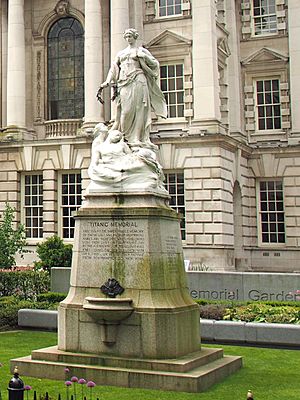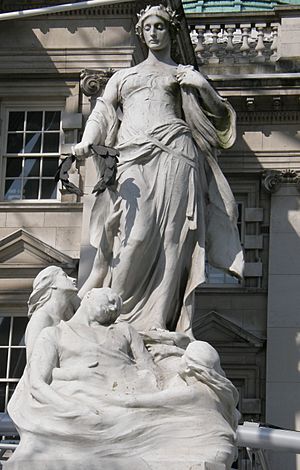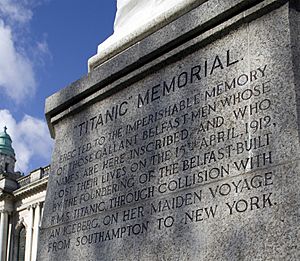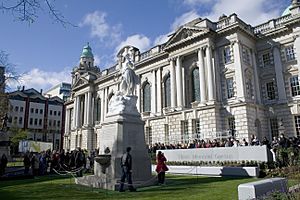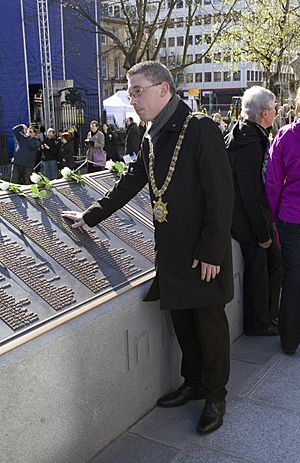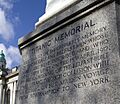Titanic Memorial, Belfast facts for kids
The Titanic Memorial in Belfast is a special monument built to remember everyone who died when the RMS Titanic sank on April 15, 1912. People from the public, workers who built the ship, and families of the victims all helped pay for it. It was officially opened in June 1920. You can find it in Donegall Square in the middle of Belfast, Northern Ireland, on the grounds of Belfast City Hall.
The memorial shows a female figure, like a symbol of Death or Fate. She holds a wreath over a drowned sailor, who is being lifted by two mermaids. This monument is used for yearly events to remember the Titanic disaster. For a while, a big Ferris wheel called the Belfast Wheel blocked it from view, but the wheel was taken down in April 2010. Now, the memorial is the main part of a small Titanic memorial garden. This garden opened on April 15, 2012, exactly 100 years after the ship sank. The memorial and garden together are the only ones in the world that remember all the victims of the Titanic, both passengers and crew.
Contents
How the Memorial Was Built
Raising Money for the Memorial
Soon after the Titanic sank, people in Belfast wanted to build a memorial for the local victims. On May 1, 1912, the Belfast City Council said they were proud of the bravery of their citizens. They also said they were sad for those who died but happy that Belfast had given the world such brave people.
On May 3, 1912, a plan was officially suggested at Belfast City Hall. Julia McMordie, whose husband was the Lord Mayor of Belfast, led the meeting. Both of them had seen the Titanic launch the year before. They decided to build:
an appropriate public Memorial, to be erected on the most prominent site available, so that it may keep green the memory [of those lost] and serve to tell succeeding generations of their heroism and devotion to duty; also that the question as to its particular character be referred to a sub-committee for consideration and report.
By the end of May 1912, about £1,035 had been collected. About one-third of this money came from the public. Workers from Harland and Wolff, the company that built the Titanic, gave £231. The family of Titanic designer Thomas Andrews, who died in the disaster, gave £360. The White Star Line, which owned the Titanic, gave £105.
Choosing a Location and Sculptor
On July 30, 1912, McMordie asked the council to find a spot for the memorial in Donegall Square North. On August 6, the city surveyor said the Donegall Square site was good. The committee then looked for a sculptor. They chose Sir Thomas Brock, a famous English sculptor. He had already made statues for Belfast, like those of Queen Victoria and Sir Edward Harland. He also created the Victoria Memorial in London. Sir Thomas Brock started working on the Titanic Memorial after the City Council approved it on January 2, 1913.
Delays and Dedication
The start of the First World War in August 1914 caused a long delay. The memorial was finally finished and put up later. On June 26, 1920, a sunny Saturday, the dedication ceremony took place. Field Marshal Viscount French, who was the last Lord Lieutenant of Ireland, officially unveiled it.
What the Memorial Looks Like
The memorial has four figures on a base, called a plinth. It stands about 22 feet (6.7 meters) tall in total. The figures themselves are carved from Carrara marble and are 12 feet (3.7 meters) high. In the middle, there is a standing female figure. Some people think she represents Fame, while others believe she is a female version of Thanatos, the Greek god of death. She holds a black laurel wreath over the heads of the three figures below her. These figures include two mermaids at her feet, holding a dead sailor above waves. The waves seem to come out of the top of the plinth.
The front and back of the plinth have two small bronze water fountains. These fountains look like the heads of gargoyle-like creatures with deep-set eyes and small noses. The front of the plinth has a special message carved into it. This message talks about the bravery of the men from Belfast who died:
Erected to the imperishable memory of those gallant Belfastmen whose names are here inscribed and who lost their lives on the 15th April 1912, by the foundering of the Belfast-built R.M.S. Titanic, through collision with an iceberg, on her maiden voyage from Southampton to New York.
Their devotion to duty and heroic conduct, through which the lives of many of those on board were saved, have left a record of calm fortitude and self-sacrifice which will ever remain an inspiring example to succeeding generations.
'Greater love hath no man than this, that a man lay down his life for his friends.'
Names of the Victims
On the sides of the plinth, you can find the names of 22 men from Belfast who died in the disaster. Their names are listed by their rank on the ship, not in alphabetical order. For example, Thomas Andrews, who was a managing director at Harland and Wolff, is listed first. The lowest-ranking crew members are at the end of the list.
Nine of the Belfast victims were part of a "guarantee party" from Harland and Wolff. They were on board the Titanic to find and fix any problems during its first trip. The rest were crew members, mostly engineers. The names are:
- Thomas Andrews – Managing Director, H&W
- William H.M. Parr – Assistant Manager Electrical Department, H&W
- Roderick Chisholm – Chief Draughtsman, H&W
- Anthony Wood Frost – Foreman Fitter, H&W
- Robert Knight – Leading Hand Fitter, H&W
- William Campbell – Apprentice Joiner, H&W
- Ennis H. Watson – Apprentice Electrician, H&W
- Francis Parkes – Apprentice Plumber, H&W
- Alfred F. Cunningham – Apprentice Fitter, H&W
- Herbert G. Harvey – Junior Assistant Engineer, Crew
- Albert G. Ervine – Assistant Electrician, Crew
- John E. Simpson – Assistant Ship's Surgeon, Crew
- William McReynolds – Junior Sixth Engineer, Crew
- Henry P. Creese – Deck Engineer, Crew
- Thomas Millar – Assistant Deck Engineer, Crew
- Hugh Fitzpatrick – Assistant Boilermaker, Crew
- Joseph Beattie – Greaser, Crew
- Matthew Leonard – Steward, Crew
- Archibald Scott – Fireman, Crew
- Hugh Calderwood – Trimmer, Crew
- Richard Turley – Fireman, Crew
- William McQuillan – Fireman, Crew
At the time, people thought 22 people from Northern Ireland had died. Only their names are on the memorial. Later research showed that 28 victims were actually from Northern Ireland. Six of these men were not listed on the memorial. They included four crew members, one Second Class passenger, and one Third Class passenger.
Moving and Restoring the Memorial
The memorial was first placed in the middle of the road on Donegall Square North. But this caused many accidents because drivers would hit it. In 1959, the Belfast City Council decided to move it. They asked for ideas for a new spot. Some suggested moving it to the fishing village of Portavogie in County Down to attract tourists.
However, it was decided to move the memorial only a few hundred yards. It was moved to the grounds of the City Hall at Donegall Square East on November 28, 1959. This move cost £1,200.
Restoration and the Memorial Garden
In 1994, a group called Consarc Design Group was hired to fix and restore the memorial. The bronze water fountains had disappeared during the 1959 move, so new ones were made to make it look like it did originally. The memorial was cleaned and renovated again in 2011–2012. The letters were re-carved and repainted so they would be easier to read. Every year on April 15, a service is held at the memorial to remember the Northern Irish victims of the Titanic sinking.
The memorial became a topic of discussion when the Belfast Wheel was built around it in November 2007. The Belfast Titanic Society did not like where the wheel was placed. They suggested moving the memorial to another corner of the City Hall grounds. The wheel was eventually closed and removed in April 2010.
After the wheel was gone, people suggested creating a memorial garden around the sculpture. This was to mark 100 years since the Titanic sank. The idea was very popular. The garden opened on April 15, 2012, with a ceremony. Lord Mayor of Belfast Niall Ó Donnghaile, Jack Martin (great-nephew of victim John Simpson), and David McVeigh (representing Harland and Wolff) laid wreaths.
The memorial garden has two levels around the Titanic Memorial. The upper level has five bronze plaques on a 9-meter (30-foot) wide base. These plaques list all 1,512 victims of the disaster, both passengers and crew, in alphabetical order. This is the first memorial in the world to list all the victims' names on one monument. The garden is planted with spring flowers like magnolias, roses, forget-me-nots, and rosemary. Their colors are meant to remind people of water and ice. Two people who died on the ship are thought to have traveled under fake names. Their pseudonyms are listed with an asterisk because their real names are still unknown.
Images for kids
See also
 In Spanish: Monumento conmemorativo del Titanic en Belfast para niños
In Spanish: Monumento conmemorativo del Titanic en Belfast para niños


